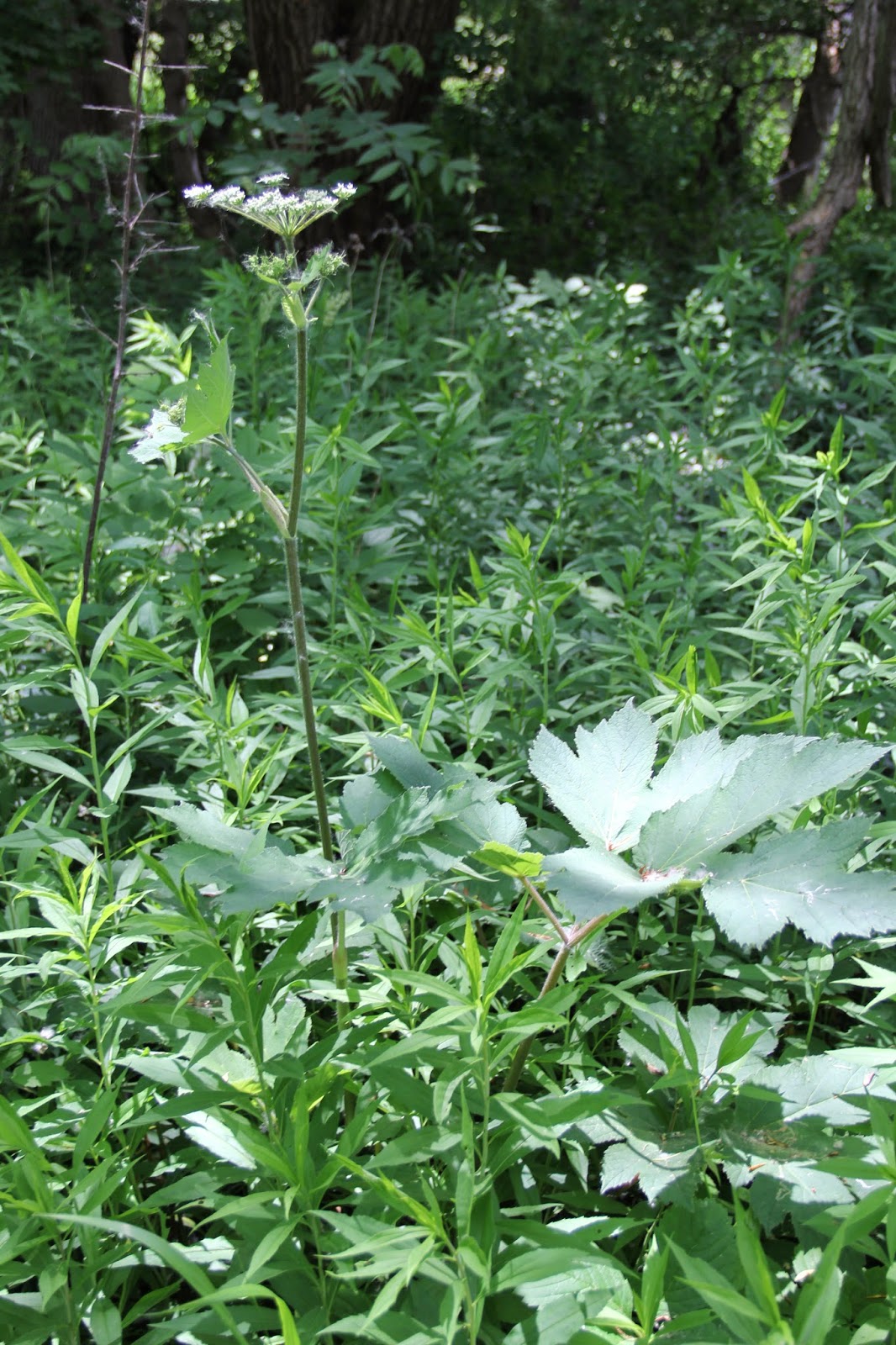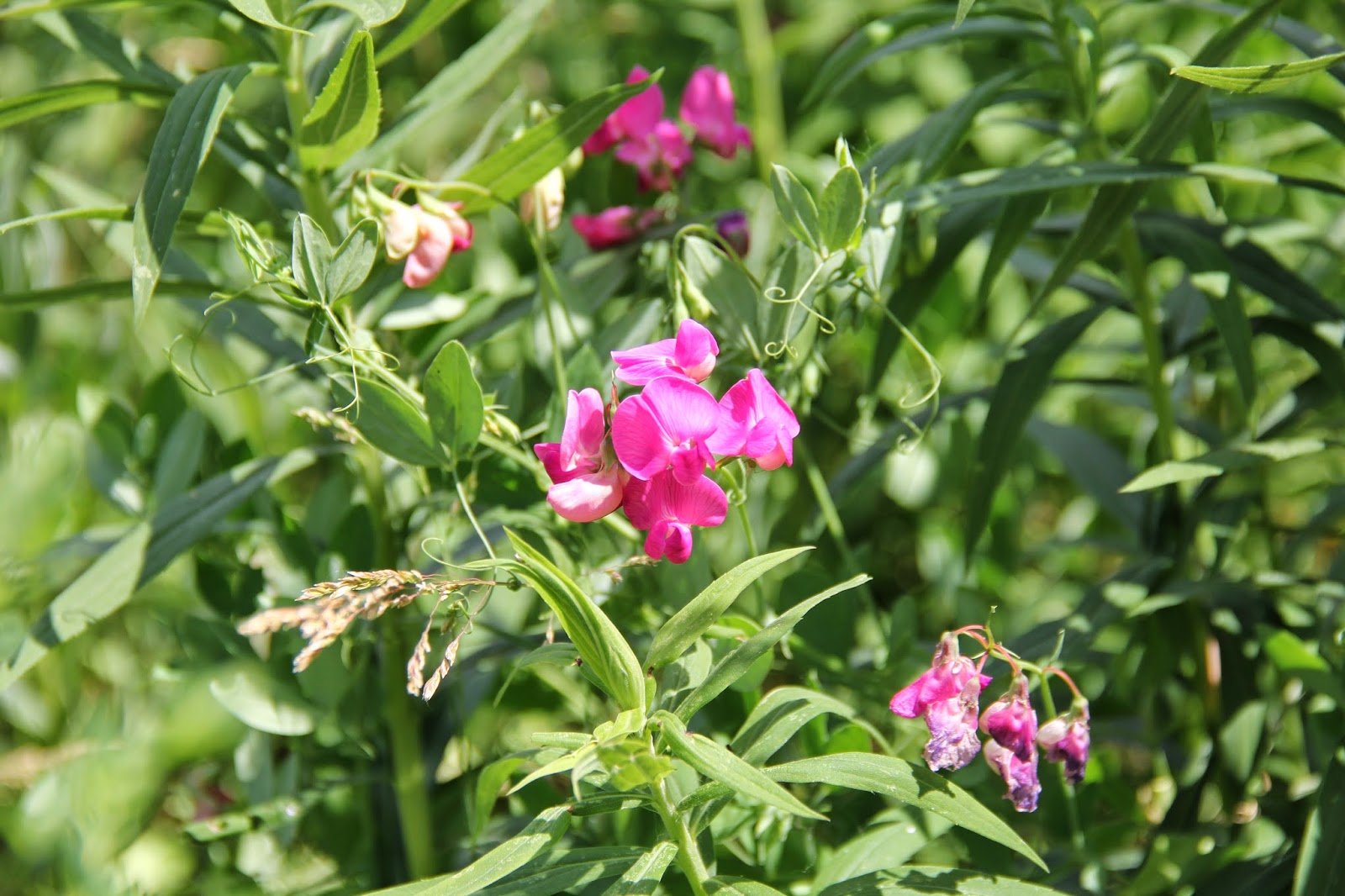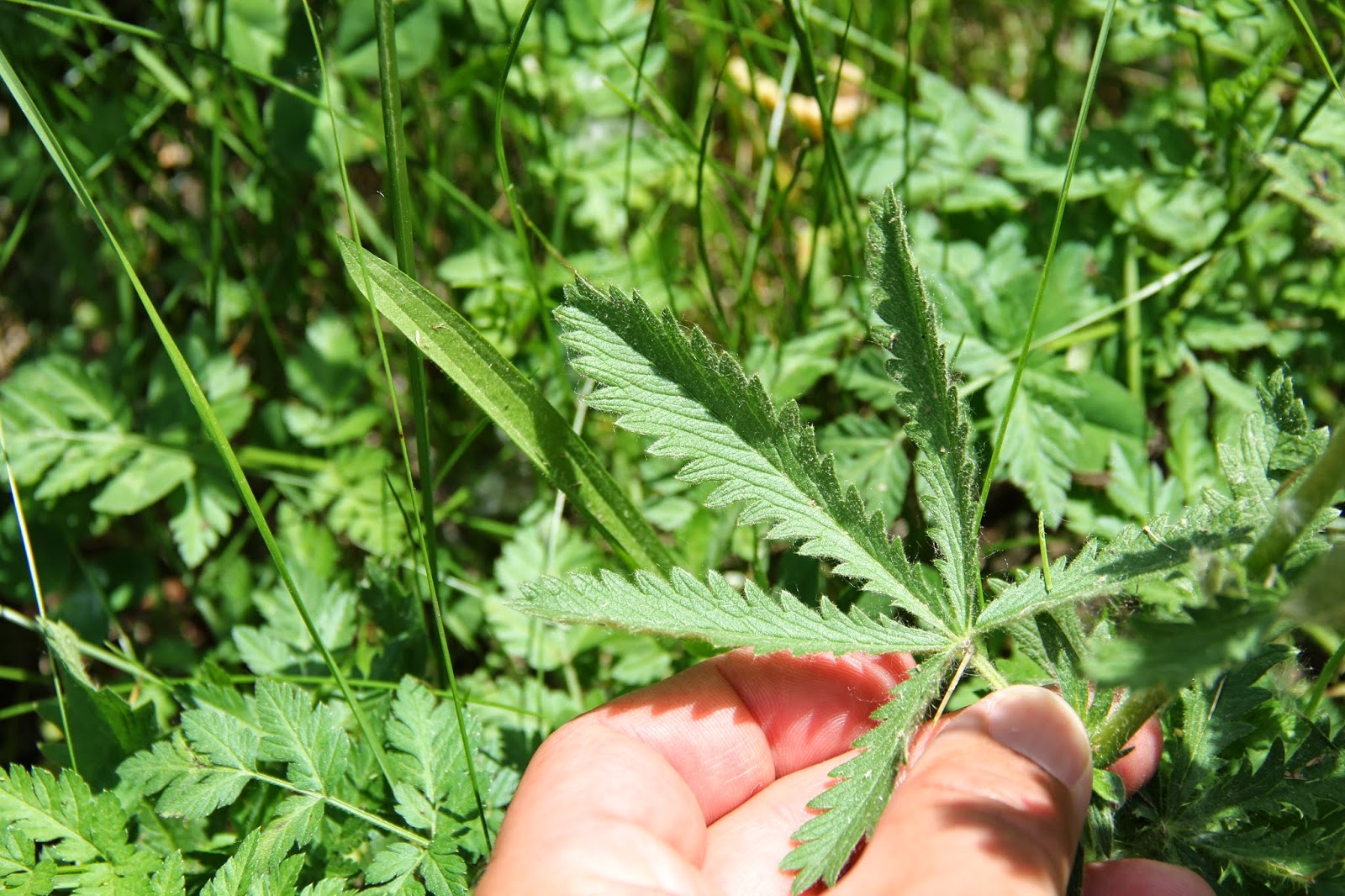Wildflowers of 2014 - #132 Wild Garlic (Allium canadense)
The first species that I found was Wild Garlic (Allium canadense). I had identified this species two weeks ago, but the plants were not in bloom. While crouching down to photograph Oriental Poppy plants (Papaver orientale) on June 3rd I smelled garlic. Looking down, I noticed that I was crouched in the middle of a small colony of Wild Garlic plants. The plants were topped with a cluster of bulblets encased in a papery husk.
 |
| Wild Garlic (Allium canadense) flowers and bulblets |
After two weeks passed, the bulblets had swollen and the papery husks have opened up revealing both the bulblets and several small flowers encased inside. The small flowers have six petals and are usually pink (sometimes white).
Wild Garlic can be found in most states east of the Rocky Mountains. In Michigan, it is found mainly in the southern half of the Lower Peninsula. Wild Garlic grows in a variety of habitats such as woodlands, meadows, and floodplains, in both sun and shade.
Wildflowers of 2014 - #133 Moonseed (Menispermum canadense)
 |
| Moonseed (Menispermum canadense) |
The next plant is another species that is typically found in floodplains and other moist wooded areas. Moonseed (Menispermum canadense) is a native vine with lobed leaves that bears a resemblance to Wild Cucumber (Echinocystis lobata), but while Wild Cucumber climbs with the aid of tendrils that wrap around objects for support, Canada Moonseed uses its main stem to twine around supports. Moonseed vines may grow to a height of 6-20 feet. The small white flowers of Moonseed have six petals and are borne in hanging panicles. After pollination small (1/4-1/3) round berries will develop. These berries are purple-blue to purple-black and are covered with a white waxy bloom. Unfortunately these berries look a lot like wild grapes. I say unfortunately because Moonseed berries are toxic and can be mistaken for edible grapes.
 |
| A closer view of the Moonseed flowers |
Wildflowers of 2014 - #134 Narrow-leafed Cattail (Typha angustifolia)
Mill Pond Park is named because much of the park fits within the former boundaries of the city's mill pond. Water from this pond was once used to power a flour mill and a sawmill. While the dams that formed this pond are now gone, the water that they held protected portions of the Chippewa River's floodplain from being developed. Part of this floodplain is now occupied by a large emergent marsh. The primary plants found growing in this marsh are cattails. There are two species of cattails found growing in this marsh (and possibly hybrids of the two species). On Monday I only found one of the two species in bloom - Narrow-leafed Cattail (Typha angustifolia).
 |
| A colony of Narrow-leafed Cattail (Typha angustifolia) |
Narrow-leafed Cattail is native to North America, but is probably not native to Michigan. It can be aggressive and will often out-compete Common Cattail (T. latifolia) when the two species are found together. Some states list Narrow-leafed Cattail as an invasive species.
 |
| Narrow-leafed Cattail |
Both species have narrow ribbon-like leaves. The width of these leaves is not a reliable way to distinguish between the two species. While Narrow-leafed Cattail generally has narrower leaves than Common Cattail, there is overlap in size.
The most reliable way to decide between the species in the field is to look at their flowers - the "cat tails". The flowers of both species are divided into two parts with the male (staminate) flowers being located near the end of the stalk and the female (pistillate) flowers located further down on the same stalk. On the Common Cattail, the two halves of the flower touch with no gap between them. The male and female flowers of Narrow-leafed Cattail are separated by a gap. Hybrids of the two species probably have a narrower gap, but there is not reliable way to identify hybrids outside the lab.
 |
| Narrow-leafed cattail - note the separation between the male (upper) and female (lower) parts of the flower |
Wildflowers of 2014 - #135 Cow Parsnip (Heracleum maximum)
The next plant is one that I wrote about earlier this Spring - Cow Parsnip (Heracleum maximum). This member of the Carrot Family (Apiaceae) is easy to identify due to its size. Cow Parsnip plants may reach a height between four and nine feet! Like other plants in this family, Cow Parsnip plants are topped with a wide flat cluster of flowers known as an umbel. Individual flowers are small, but the umbels may be up to 8 inches across.
 |
| Cow Parsnip rising above the surrounding vegetation |
 |
| Cow Parsnip - a closer view of the flowering umbel |
Cow Parsnip can be found growing in any low wet area including floodplains, swamps, shorelines, roadside ditches , etc..
For more information please see my post about Cow Parsnip from March 25th.
Wildflowers of 2014 - #136 Everlasting Pea (Lathyrus latifolius)
I found Everlasting Pea (Lathyrus latifolius) growing in an open dry area along the Chippewa River. This non-native vine is also known as Perennial Pea. It was originally introduced to North America as a decorative plant, being grown for its large (up to 1 1/4 inches), showy, pink flowers. It is now found in every state except Alaska, North Dakota, and Florida.
 |
| Everlasting Pea (Lathyrus latifolius) |
Each Everlasting Pea vine can grow up to 6 feet. The vines either trail along the ground or climb nearby objects with the aid of grasping tendrils which coil around and support the plant's weight. The compound leaves of Everlasting Pea are arranged alternately along the vine, with each leaf having a single pair of leaflets.
 |
| Everlasting Pea - note the typical pea flower shape with banner (petals that looks like a basketball backboard), wings (the two petals beneath the banner) , and keel (hidden under the wings) |
Wildflowers of 2014 - #137 Cursed Crowfoot (Ranunculus scleratus)
The sixth wildflower find of the day was member of the Butercup Family - Cursed Crowfoot (Ranunculus scleratus). Also knows as Cursed Buttercup or Celery-leafed Buttercup, this is the fourth Ranunculus species on my 2014 list. Like many of the other Buttercup species, Cursed Crowfoot prefers wet soils; I found this plant growing in a low muddy area within the river's floodplain. This species is found throughout the Northern Hemisphere and some plants found in North America may have been introduced from Europe.
 |
| Cursed Crowfoot in typical wet habitat |
Cursed Crowfoot is fairly easy to identify. It's leaves are oval or kidney shaped with three deep lobes. The stems of the plant branch repeatedly.The leaves and the stems are more succulent than other Ranunculus species - this means that that the are very juicy. This juice is considered toxic and may cause blisters. Use caution if handling.
 |
| Cursed Crowfoot - note the lobed leaves |
The flowers are small measuring only 1/4 to 3/8 inch across. Each flower has 5 yellow petals surrounding a tightly-packed cylinder of pistils. This cylindrical center is distinctive of this species.
 |
| Cursed Crowfoot (Ranunculus scleratus) - note the distinctive cylindrical flower |
Wildflowers of 2014 - #138 Rough-fruited Cinquefoil (Potentilla recta)
The next flower that I found is another introduced species - Rough-fruited Cinquefoil (Potentilla recta). Also known as Sulphur Cinquefoil, this native of Eurasia is now found across most of North America with the exceptions of the Desert Southwest and Canadian Arctic. It grows on roadsides, in fields and meadows, and other weedy places.
 |
| Rough-fruited Cinquefoil (Potentilla recta) |
Of the fifteen Potentilla species that are found in Michigan, Rough-fruited Cinquefoil is one of the easier species to identify. It has pale yellow flowers with five heart-shaped petals. The compound leaves are the most distinguishing characteristic of this species. Each leaf has 5-7 leaflets arranged palmately (radiating outward from a central point) with coarsely toothed margins.
 |
| Rough-fruited Cinquefoil - note the Hover Fly nectaring at the pale yellow flower |
 |
| Rough-fruited Cinquefoil - note the distinctive leaf shape |
Wildflowers of 2014 - #139 Crown-vetch (Securigera varia)
The final flower of the day was another non-native species. Crown-vetch (Securigera varia) is commonly planted for erosion control and has naturalized across much of the United States and Canada.
 |
| Crown-vetch (Securigera varia) |
Crown-vetch is a member of the Legume family and has flowers with the typical pea shape. The pink and white flowers are arranged in a round dense cluster that resembles a crown.
 |
| Crown-vetch - a closer view of the "crown" of flowers |
Crown-vetch vines can grow to a height of 1-3 feet. While the plants may use other vegetation for support, the vines lack climbing tendrils. The leaves of Crown-vetch are arranged alternately along the stem, with each compound leaf being composed of an odd number (11-25) of leaflets. The plant can reproduce both by seed and by underground rhizomes. Because of these dual methods of reproduction, Crown-vetch often forms dense colonies that crowd out other plant species.
No comments:
Post a Comment